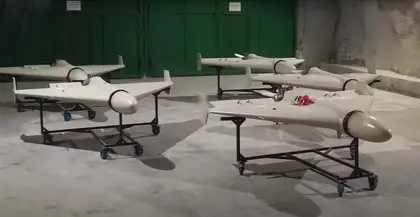Tehran has deployed dozens of military instructors to the Kremlin-occupied Crimea peninsula and Kherson region to help the Russian army launch kamikaze drone strikes against Ukrainian targets, independent Ukrainian news platforms said on Oct. 18.
Ukrainian news agency UNIAN, citing “underground” intelligence sources, reported an undisclosed number of trainers stationed at a training center at the Russian Federation (RF)-operated Kirov airfield near Crimea’s Cape Tarkhankut. They are reportedly assisting RF troops to fire Shahed-136 suicide drones at Ukrainian homes, businesses and infrastructure.
JOIN US ON TELEGRAM
Follow our coverage of the war on the @Kyivpost_official.
Ukraine’s military estimated that 36 Shahed-136 drones were fired late on Oct. 16 and into the morning hours of Oct. 17 towards at least eight Ukrainian cities. They targeted residential and business centers and power grid infrastructure. Ukrainian air defense units using missiles and auto-cannon, along with police and even private citizens using small arms, shot down at least 24 of the drones, a Ukrainian Air Force statement said.
At least 20 more Iranian instructors were working at an RF-occupied location in Ukraine’s Kherson region, the UNIAN report said. Andriy Tsaplienko, a widely read independent Ukrainian journalist, confirmed the accuracy of the UNIAN article, citing sources in the state-sponsored Center for National Resistance, a volunteer-staffed organization with close links to the Ukrainian military and intelligence communities.

Diane Francis Interviews Mikhail Zygar, Yaroslav Trofimov on Prospects of Russia’s War on Ukraine
Iranian Foreign Ministry spokesperson Nasser Kanaani denied on Oct. 17 that Tehran was supplying Russia drones. Officials in Kyiv, Brussels and Washington have widely rejected the denial.
The Kremlin on Oct. 2 opened an attack drone and cruise missile bombardment against Ukraine, aimed at crushing Ukraine’s power grid and the Ukrainian public’s will to resist. Since then, Ukrainian media, including Kyiv Post reporters, have reported hundreds of Shahed-136 sightings and dozens of strikes.
State-run RF television has also reported the Kremlin’s purchase of hundreds of kamikaze drones from Iran and was using them to attack Ukraine. Olga Skabayeva, a leading RF propagandist, confirmed during an Oct. 17 talk show that the drones were from Iran. She argued that Ukraine’s continuing resistance and unwillingness to surrender leaves Russia no other option.
“Once again, I assert that we’re forced to conduct these strikes. They [Ukraine] leave us no choice,” Skabayeva said.
Latest round of attacks
Russia on Oct. 17 launched yet another wave of strikes, using both suicide drones and guided missiles.
A primary target appeared to have been the capital Kyiv. Ukrainian air defense information networks between 7:00-7:15 a.m., reported that a Kremlin Tu-95 bomber had launched X-101 cruise missiles from air space above Russia’s Belgorod Oblast. Armed Forces of Ukraine (AFU) units reported that they had shot down at least two of the incoming weapons but three struck the vicinity of a power generation station in Kyiv’s northern Brovary district.
Official statements and video from the scene showed smoke and fire rising from the TPP-6 power station. Emergency response teams were on the scene within five minutes of the strike. A longtime Brovary resident told Kyiv Post that the strike cut power to his home for some 90 minutes. There were no reports of casualties. News agencies showed some residents in Kyiv’s northern districts lined up at shops to buy supplies of food and water.
In the southern city Mykolaiv, the RF military used a mix of Iranian kamikaze drones and RF-manufactured S-300 missiles in a series of nighttime attacks, with more than a dozen weapons launched and explosions hitting a two-story residential building. In a central district they also struck the city’s historic, tree-lined flower bazaar. One man died and five of the suicide drones were shot down, regional defense commander Vitaly Kim told reporters.
President Volodymyr Zelensky in a morning statement said: “Ukraine is still being bombarded by invaders. The stench is still there from those who are best at terrorizing and attacking peaceful people. In Mykolaiv, with S-300 missiles, the enemy blew up an apartment building and a person died. Also, a flower market on a square surrounded by chestnut trees was demolished. Why did Russian terrorists attack these absolutely peaceful places?”
Social media and officials in the central industrial city of Dnipro, reported air defense systems firing at incoming weapons, followed by two explosions in the vicinity of one of Dnipro’s power stations.
Valentryn Reznichenko, a ministry of emergency situations spokesman, said in a Telegram statement that the strike “caused serious damage…and a fire,” that the electricity supply to the city’s Synelnykove and Vasylkivka districts was lost, and the city’s water pumping station was forced to work at reduced capacity. He added that four missiles aimed at Dnipro were shot down.
A DTEK Energo power company statement said that one worker died in the attack. Emergency response and repair crews were on the scene, he said.
Two more RF missiles struck power infrastructure in the north-western city of Zhytomyr. Mayor Serghy Sukhomlin said much of the city and 11 villages nearby were left without electricity, and that hospitals were operating on backup power. Repair crews were working to bring the grid back online, he said.
The eastern city of Kharkiv was hit by four S-300 missiles, a statement from the Regional State Administration, said. An expensive weapon designed for an anti-aircraft role, the S-300 has been increasingly used by RF forces as a ground bombardment weapon in recent months.
According to military observers, the RF is running short of long-range guided missiles, which has forced the Kremlin to repurpose anti-aircraft missiles and buy attack drones from Iran.
You can also highlight the text and press Ctrl + Enter






